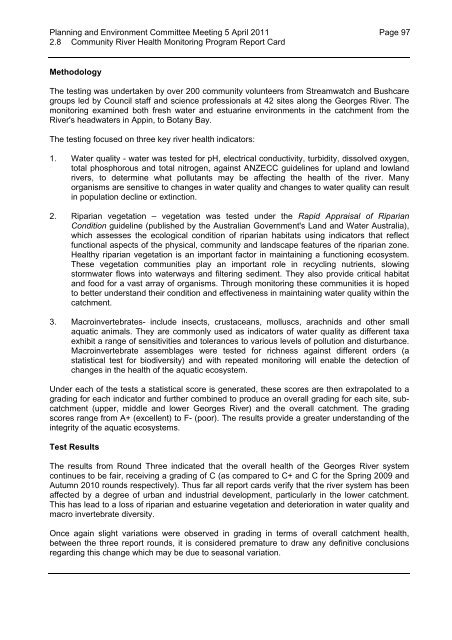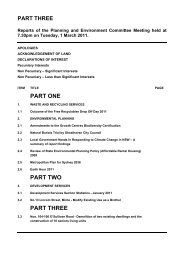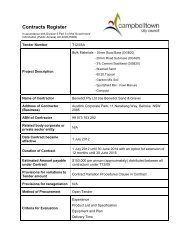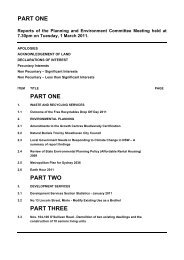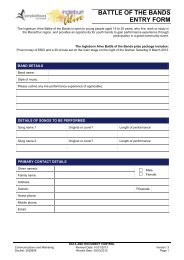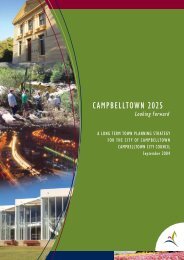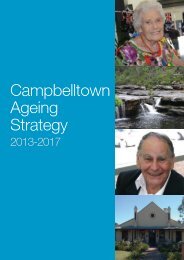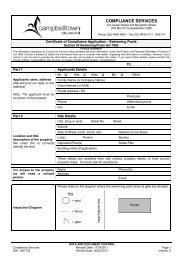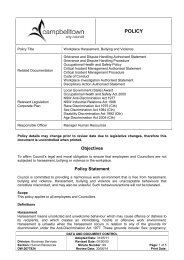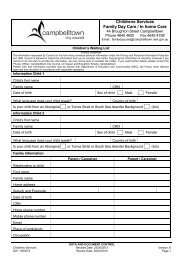PART ONE - Campbelltown City Council - NSW Government
PART ONE - Campbelltown City Council - NSW Government
PART ONE - Campbelltown City Council - NSW Government
Create successful ePaper yourself
Turn your PDF publications into a flip-book with our unique Google optimized e-Paper software.
Planning and Environment Committee Meeting 5 April 2011 Page 972.8 Community River Health Monitoring Program Report CardMethodologyThe testing was undertaken by over 200 community volunteers from Streamwatch and Bushcaregroups led by <strong>Council</strong> staff and science professionals at 42 sites along the Georges River. Themonitoring examined both fresh water and estuarine environments in the catchment from theRiver's headwaters in Appin, to Botany Bay.The testing focused on three key river health indicators:1. Water quality - water was tested for pH, electrical conductivity, turbidity, dissolved oxygen,total phosphorous and total nitrogen, against ANZECC guidelines for upland and lowlandrivers, to determine what pollutants may be affecting the health of the river. Manyorganisms are sensitive to changes in water quality and changes to water quality can resultin population decline or extinction.2. Riparian vegetation – vegetation was tested under the Rapid Appraisal of RiparianCondition guideline (published by the Australian <strong>Government</strong>'s Land and Water Australia),which assesses the ecological condition of riparian habitats using indicators that reflectfunctional aspects of the physical, community and landscape features of the riparian zone.Healthy riparian vegetation is an important factor in maintaining a functioning ecosystem.These vegetation communities play an important role in recycling nutrients, slowingstormwater flows into waterways and filtering sediment. They also provide critical habitatand food for a vast array of organisms. Through monitoring these communities it is hopedto better understand their condition and effectiveness in maintaining water quality within thecatchment.3. Macroinvertebrates- include insects, crustaceans, molluscs, arachnids and other smallaquatic animals. They are commonly used as indicators of water quality as different taxaexhibit a range of sensitivities and tolerances to various levels of pollution and disturbance.Macroinvertebrate assemblages were tested for richness against different orders (astatistical test for biodiversity) and with repeated monitoring will enable the detection ofchanges in the health of the aquatic ecosystem.Under each of the tests a statistical score is generated, these scores are then extrapolated to agrading for each indicator and further combined to produce an overall grading for each site, subcatchment(upper, middle and lower Georges River) and the overall catchment. The gradingscores range from A+ (excellent) to F- (poor). The results provide a greater understanding of theintegrity of the aquatic ecosystems.Test ResultsThe results from Round Three indicated that the overall health of the Georges River systemcontinues to be fair, receiving a grading of C (as compared to C+ and C for the Spring 2009 andAutumn 2010 rounds respectively). Thus far all report cards verify that the river system has beenaffected by a degree of urban and industrial development, particularly in the lower catchment.This has lead to a loss of riparian and estuarine vegetation and deterioration in water quality andmacro invertebrate diversity.Once again slight variations were observed in grading in terms of overall catchment health,between the three report rounds, it is considered premature to draw any definitive conclusionsregarding this change which may be due to seasonal variation.


